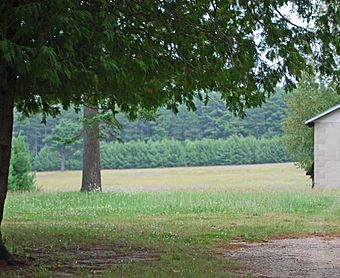Skegemog Point Site facts for kids
Quick facts for kids |
|
|
Skegemog Point Site
|
|
 |
|
| Location | 8298 Skegemog Point Rd. Williamsburg, Michigan |
|---|---|
| Area | 15.5 acres (6.3 ha) |
| NRHP reference No. | 72001474 |
| Added to NRHP | March 24, 1972 |
The Skegemog Point Site, also called the Samels Field Site, is a special place where scientists study the past. It's an archaeological site, which means it's a spot where people lived long ago. This site is located on the Samels Farm near Williamsburg, Michigan.
What makes this site amazing is that it holds clues from over 10,000 years of history! Usually, older things are found deeper underground. But here, due to something called glacial rebound, the land slowly rose over time. This means older artifacts are found higher up and further from the lake, while newer ones are closer to the water. The site was added to the National Register of Historic Places in 1972. This list helps protect important historical places in the United States.
Contents
Discovering the Past at Skegemog Point
How Was the Site Found?
In 1889, Frank and Mary Samels bought 64 acres of land on Skegemog Point. This area is a piece of land between Lake Skegemog and Elk Lake. As Frank farmed his land, he started finding many old Native American tools. These included arrow points and axes. He also noticed many small mounds and pits along the lakeshore.
Early Studies and Excavations
In the 1920s, an archaeologist from the University of Michigan came to look at the site. Later, in 1930, Wilbert B. Hinsdale, who was in charge of the archaeology department, did more research there. Frank Samels passed away in 1955. His three sons, Dennis, Ben, and Rob Samels, then took over the farm.
In 1965, the Samels brothers gave permission for more digging. Charles Cleland, a museum expert from Michigan State University, led this work. Cleland found clear signs that people had lived at this spot for a very long time. Because of its importance, the site was placed on the National Register of Historic Places in 1972.
Protecting the Site for the Future
In the 1990s, the Samels family worked with The Archaeological Conservancy. This group helps protect important archaeological sites. They made an agreement to keep the entire farm safe, including the ancient site. After the last Samels brother died in 2002, the Conservancy leased the farm. It became an education center run by the Samels Family Heritage Society. This center helps people learn about the site's history.
What Makes Skegemog Point Unique?
Layers of History: Paleo-Indian to Late Woodland
The Skegemog Point Site holds artifacts from many different time periods. These include the Paleo-Indian period, the Archaic period, and the Late Woodland period. The artifacts are mostly found on or near the surface. They are spread out over about 15.5 acres, reaching from the land into the lake itself.
Understanding Horizontal Layers
This site is special because it is "horizontally stratified." This means that different time periods are found in different areas, rather than stacked on top of each other. The oldest part of the site, from the Paleo-Indian period (around 10,000 BCE), is found at the highest point, furthest from the lake. This is because of glacial rebound. This is when the land slowly rises after heavy glaciers melt away.
The Archaic period section, from about 3000 BCE, is found closer to the lakeshore. The most recent section, from the Late Woodland period (around 900-1200 AD), is located closest to the water. This horizontal layering gives scientists a clear timeline of how people lived here as the land changed.
What Was Found at the Site?
The Late Woodland section of the site was partly dug up in the 1960s. Scientists found at least 26 hearth areas, which are old fire pits. They also found charcoal, pieces of pottery (called potsherds), animal bone fragments, and seeds. They even found marks in the ground from old posts. These postmolds were in circles about 10 feet wide. This suggests that people built temporary homes, like wigwam-type structures, in these spots.
Other parts of the site have not been dug up as much. However, very old stone tools called Clovis points have been found in the older sections of the site. These tools are a key sign of early Paleo-Indian people.



